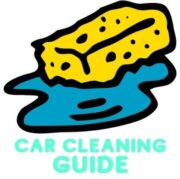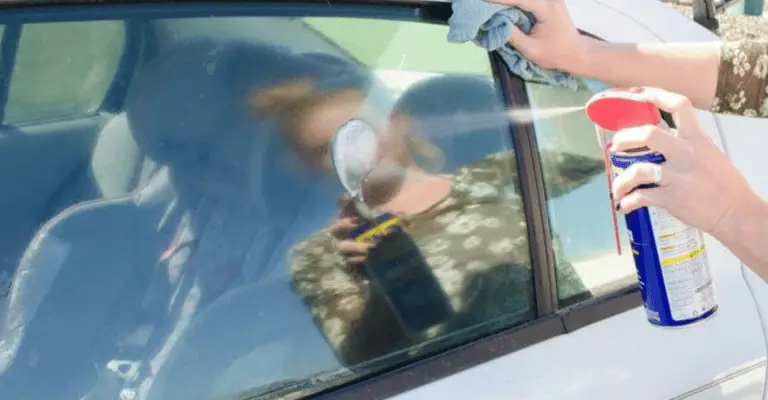Last Updated on November 9, 2023 by Chase Manhattan
In the world of car maintenance and detailing, WD 40 is a well-known name.
It’s a versatile product, used in various applications, from loosening rusty parts to removing tough stains. But one question often asked is, “will wd 40 hurt car paint?” This article aims to answer this question and shed light on all things WD 40 and car paint.
Keep in mind that car paint is more than just a vehicle’s cosmetic aspect. It protects the metal underneath from corrosion, UV damage, and harsh weather conditions. Therefore, anything that could potentially harm this protective layer is a concern for car owners. To understand the effects of WD 40 on car paint, we first need to delve into the types of chemicals that might damage car paint. So keep reading, and lets get to it!
- How to Clean Car Carpets Quick and Easy - July 10, 2024
- Can You Touch Up Clear Coat? Yes and No (Here’s Why) - November 25, 2023
- How To Wax A Car By Hand: A Comprehensive Guide - November 14, 2023

Quick Navigation
What Are Some Chemicals That Damage Car Paint?
Certain chemicals are notorious for causing damage to car paint. These include, but are not limited to, strong acids and bases, solvents like acetone, and certain types of cleaners such as bleach. These substances can cause the paint to fade, peel, or even blister.
Moreover, some abrasive cleaners can scratch the clear coat, which is the outermost layer of car paint. Once this protective layer is compromised, it leaves the underlying paint and metal vulnerable to damage. Therefore, it’s crucial to be mindful of the products you use on your car and always test a small, inconspicuous area first if you’re unsure.
Chemical Composition of WD-40
WD-40’s formula, while not entirely public, is known to contain a blend of ingredients that work together to provide its unique properties. The primary components include:
- Petroleum-Based Oils: These oils form the base of WD-40, offering excellent lubrication and moisture displacement properties. They help in loosening rusted parts and providing a smooth surface on car paint.
- Aliphatic Hydrocarbons: These are the solvents in WD-40 that help dissolve grease and grime, making it easier to clean tough stains on car surfaces.
- Non-Volatile Components: These elements give WD-40 its staying power, ensuring that it doesn’t evaporate quickly and continues to protect the surface it’s applied to.
How Do These Chemicals Affect a Car’s Paint?
- Protective Qualities: The petroleum oils in WD-40 can create a thin protective layer on car paint, guarding against moisture and minor rust.
- Potential Risks: If left on the car paint for extended periods, WD-40 can attract dust and dirt, potentially leading to minor scratches. It’s essential to use it correctly and clean it off after application.
Read more: What is clear coat protectant?
Will WD 40 hurt car paint?
Having established the types of chemicals that can harm car paint, let’s address the burning question: Will WD 40 hurt car paint? The short answer is no. WD 40 is a light-duty petroleum-based lubricant and rust remover, which is safe for most surfaces, including car paint.
However, this doesn’t mean that WD 40 should be used carelessly on car paint. Certain conditions and misuse can lead to undesirable effects. For example, leaving WD 40 on car paint for an extended period without cleaning it off might attract dust and grime, which can lead to minor scratches.
Quick Summary: Talking Points and More to Come
- WD-40 is a versatile product used in car maintenance and detailing for various applications.
- Car paint is not just cosmetic; it protects the metal from corrosion and damage.
- Certain chemicals can harm car paint, but WD-40 is generally safe for car paint.
- WD-40 should be used sparingly and only for specific applications, like removing tar or bird droppings.
- WD-40 is not a substitute for car wax or polish and won’t remove deep scratches.
- Proper usage involves spot testing, wiping off after a few minutes, and washing the area with soapy water.
- Alternatives to WD-40 exist for specific tasks, such as dedicated tar and bug removers for stubborn substances.
- Being informed about the effects and proper usage of WD-40 on car paint is essential for maintaining paint condition.
Reference Video
Common misconceptions about WD 40 and car paint
There are numerous misconceptions about using WD 40 on car paint. One such myth is that WD 40 can be used as a substitute for car wax or polish. While it can give the paint a temporary shine, it doesn’t offer the same protection as a dedicated car wax or polish.
Another misconception is that WD 40 can remove scratches from car paint. While it can help to hide minor scratches temporarily, it does not ‘remove’ them. For deeper scratches that have penetrated the clear coat, professional repair is usually needed.
The right way to use WD 40 on car paint
Now that we’ve debunked some common misconceptions, let’s look at the proper way to use WD 40 on car paint. First, it should be used sparingly and only for specific applications, such as removing tar, tree sap, or bird droppings.
After applying WD 40, let it sit for a few minutes to break down the stubborn substance. Then, gently wipe it off with a clean, soft cloth. Finally, always remember to wash the area with soapy water to remove any residue and prevent the attraction of dust and grime.
Examples of Safe and Practical Application of WD 40
Lubricating and Protecting Door Hinges
Scenario: Squeaky or stiff car door hinges can be a nuisance. WD-40 can be used to lubricate these hinges, ensuring smooth operation.
Application Steps:
- Clean the Hinge: Wipe down the hinge area to remove any dirt or grime.
- Apply WD-40: Spray WD-40 directly onto the hinge, ensuring full coverage.
- Work the Hinge: Open and close the door several times to work the WD-40 into the hinge mechanism.
- Wipe Excess: Use a clean cloth to remove any excess WD-40 to prevent dust accumulation.
Restoring Faded Plastic Trim
Scenario: Over time, the plastic trim on cars can become faded and lose its original luster. WD-40 can help restore the appearance of this trim.
Application Steps:
- Clean the Trim: Thoroughly clean the plastic trim to remove any dirt or residue.
- Apply WD-40: Spray a small amount of WD-40 onto a clean cloth and gently rub it onto the plastic trim.
- Buff the Surface: Use a dry cloth to buff the surface, bringing back the shine to the plastic trim.
- Repeat if Necessary: For severely faded trim, a second application may be required.
Removing Old Stickers and Decals
Scenario: Removing old stickers or decals from car paint or windows can be challenging without damaging the surface.
Application Steps:
- Heat the Sticker: Use a hairdryer to gently heat the sticker, which helps loosen the adhesive.
- Apply WD-40: Spray WD-40 onto the edges of the sticker and let it sit for a few minutes.
- Peel Off the Sticker: Start peeling the sticker from a corner. If it resists, apply more WD-40 and gently scrape with a plastic card.
- Clean the Residue: Once the sticker is off, use WD-40 to remove any remaining adhesive, then clean the area with soapy water.
Do’s and Don’ts for WD40 and Car Paint
| Do's | Don'ts |
|---|---|
| Spot test: Test in a small, inconspicuous area before widespread use. | Don't leave WD-40 on car paint for extended periods; promptly wipe it off. |
| Use sparingly: Apply WD-40 only for specific tasks like removing tar or bird droppings. | Don't use WD-40 as a substitute for dedicated car wax or polish. |
| Clean thoroughly: Wash the area with soapy water after using WD-40 to remove residue. | Don't apply WD-40 on freshly painted surfaces or new car paint. |
| Use on tough stains: WD-40 can be helpful in removing stubborn substances. | Don't overspray WD-40 on non-paint surfaces, like rubber or plastics. |
| Protect with wax: Follow up with a quality car wax to maintain paint protection. | Don't use WD-40 as a scratch remover; it won't eliminate deep scratches. |
| Follow instructions: Use WD-40 according to the manufacturer's guidelines. | Don't use WD-40 excessively; use it only when necessary. |
| Consider alternatives: Opt for dedicated tar and bug removers for tough substances. | Don't expect long-term protection from UV rays or scratches with WD-40. |
| Gently wipe: Use a soft cloth to gently wipe off WD-40 after application. | Don't use WD-40 on car windows; it can cause streaks and reduce visibility. |
| Spot clean: Use WD-40 to target specific stains or marks on car paint. | Don't use WD-40 for overall car paint maintenance; choose appropriate products instead. |
Alternatives to WD 40 for car paint
While WD 40 is safe to use on car paint, there are alternatives available that might be better suited for certain tasks. For instance, dedicated tar and bug removers are available that are specifically formulated to safely remove these substances from car paint.
For minor scratches, there are products such as scratch removers or fillers that can do a better job than WD 40. Similarly, for a shiny finish, using a quality car wax or polish is always the best option.
FAQs and Related Questions
Will WD-40 damage the paint on my car?
WD-40 is generally safe for car paint when used properly. However, there are some precautions to consider.
Can I use WD-40 to remove stains or marks on my car’s paint?
Yes, WD-40 can help remove stains or marks on car paint. But, it’s essential to spot test in an inconspicuous area first.
Does WD-40 protect car paint from scratches or UV rays?
WD-40 is not a dedicated protectant for car paint and does not offer long-term protection from scratches or UV rays.
Can I use WD-40 to remove sticky residue or adhesive from my car’s paint?
Yes, WD-40 can be effective in removing sticky residue or adhesive from car paint. Be sure to clean the area thoroughly afterward.
Conclusion: WD 40 and Car Paint
In conclusion, the answer to the question “will wd 40 hurt car paint?” is a resounding no, provided it’s used correctly and for the right applications. It’s a versatile product that can help car owners deal with stubborn substances on their paint. However, it’s not a substitute for products specifically designed for car paint maintenance and should not be used as such.
Remember, car paint is more than just your vehicle’s aesthetic aspect; it’s also the protective layer that keeps the underlying metal safe. Therefore, it’s crucial to use products that are safe and beneficial for your car’s paint.
In the end, whether you choose to use WD 40 on car paint or not is a personal decision. However, being informed about its effects and proper usage is key to ensuring your car’s paint stays in top condition.


